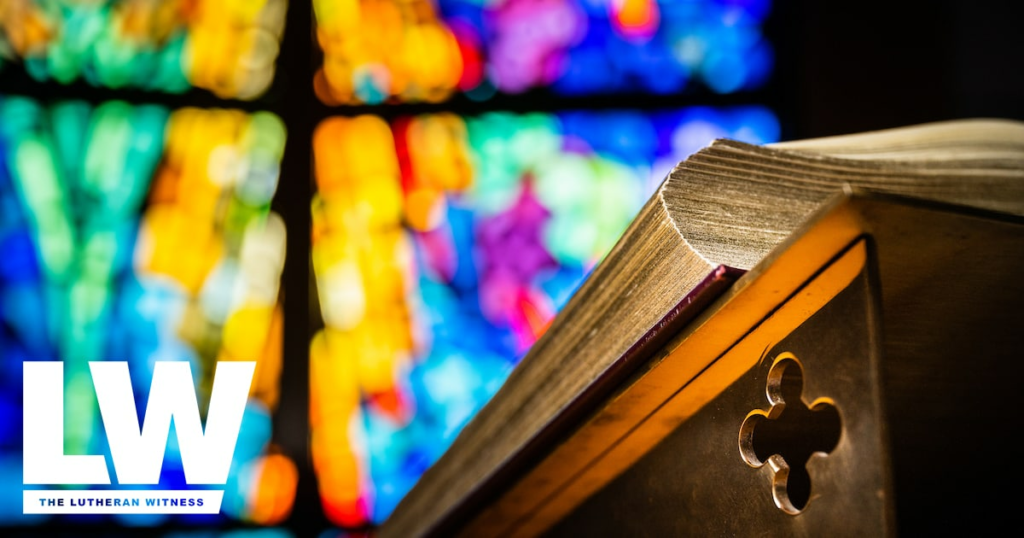by Rev. Nicholas Huelsman
The point of Christmas is that now, when you look at Jesus, you see the face of God. The Old Testament record also points to a presence of the Lord among men, but that presence is undoubtedly something outside humanity. St. John communicates this divine transition when he writes, “And the Word became flesh and dwelt among us” (John 1:1). The most important aspect of Christmas is the incarnationthe process of God taking on human flesh. God has become touchable and visible in, with and under the Baby Jesus. God is a human being.
As parents, one of the greatest challenges we have, especially as the Christmas season approaches, is how to relate this historic event to our children in a meaningful and understandable way. But before you begin with this important task of teaching Christmas to your child, keep this in mind: Your child already believes the incarnation.
In fact, in Baptism, we are blessed to receive the faith that clings to every divine truth of Holy Scripture. What you are offering your child, therefore, is not a foreign concept, but one that is already an integral part of his or her life. In teaching him, you are simply giving him the words and intellectual capacity to communicate what he already believes. So, if your child does not seem to get it right away, or even if you can’t seem to put it all together, you may rest in the certain blessing of your Baptism. After all, it was not for their intellectual achievements that Jesus exemplified the children (Mark 10:15), but rather for the gift of faith that is theirs already in Baptism.
As a general guide in communicating this timeless truth of the incarnation, consider the following principle: To make the incarnation real for your child means that you must bring him into the narrative of the Christmas story itself. This can be accomplished in two ways: historically and sacramentally.
Historical
You will want to nurture within your child the realization that Jesus was a real baby. This will be easiest if you have a real baby on hand. Another option is to sit him down in front of a mirror and tell him that Jesus was a real child, just as he is. Have fun with this; point to all the features on your child’s face and say, “Just like Jesus.”
Since the incarnation is not only a teaching but is, in fact, the whole way we understand God, it is important for this to really sink in for your child. Explain that Jesus too has a mother, that He also grew inside His mother’s “belly,” that He also cried, had to learn how to use the potty, to walk, tie His sandals, talk and so on.
Sacramental
The second and the most important way for you and your child to know the incarnation today is to know the real, fleshly presence of Jesus as He makes Himself available to all the baptized in His body and blood in Holy Communion.
One of the simplest ways your child learns about the Lord’s real presence (Jesus’ continued incarnation) is by witnessing it in the Divine Service. The example you set in reverence and respect for the House of God will teach volumes about what is really going on there.
To receive the real body and real blood of the Incarnate One is the most fundamental and powerful way your child will know and come to understand the reality of Christmas. The Lutheran ChurchMissouri Synod’s rite of “First Communion Prior to Confirmation” allows baptized children to receive the Lord’s Supper once they have learned the Small Catechism and received instruction in the basic tenets of the faith. As a parent, consider working through this possibility with your pastor. Ask him to explain the rite to you and to discuss what it means for your child. He can even give you a copy of “Guidelines for Pastoral Examination of Catechumens” from the Pastoral Care Companion, which will give you an understanding of his responsibilities as a pastor as he theologically examines a baptized child prior to receiving Holy Communion.
Historically and sacramentally, you and your child grow in the knowledge of the incarnate God of Christmas. Once a baby, now enfleshed for us to eat and drink, Jesus is real, and He is really God with us.
—
> “On Christmas morning, more than eight-out-of-10 Americans celebrate the birth of Jesus Christ” (Rasmussen Reports).
About the author: The Rev. Nicholas Huelsman is pastor of Saint John Lutheran Church, Victor, Iowa.
Additional Resources
Christmas Night, Fair and Bright
With simple words and a rhyme scheme ideal for children ages 4 to 7, this book recreates the sights and sounds of the first Christmas. ChristmasNight emphasizes the two natures of ChristHis abject humility and His true divinity. With each verse, Jesus’ perfect life and death on our behalf is underscored.
What Happened to Merry Christmas?
As Christmas becomes more commercial and secular, Christian parents are increasingly challenged to teach about the real meaning of the day and about celebrating our Savior’s birth. In this story for children ages five and up, the message of God’s love in Jesus and the story of His birth are found in the symbols and traditions of even a modern Christmas.
Fear Not, Joseph!
Scripture offers little about the man who married Mary and reared Jesus, but Joseph was key to God’s promise to send a Savior. Jesus was not his biological son, but God made Joseph His adopted father, the provider and caretaker of Mary and our Savior, Jesus.
Go to www.cph.org
—
December 2011





